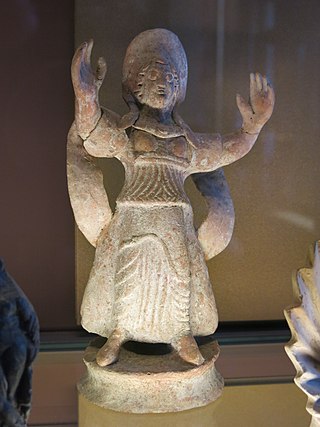Year 135 BC was a year of the pre-Julian Roman calendar. At the time it was known as the Year of the Consulship of Flaccus and Piso and the Sixth Year of Jianyuan. The denomination 135 BC for this year has been used since the early medieval period, when the Anno Domini calendar era became the prevalent method in Europe for naming years.
Mithridates or Mithradates is the Hellenistic form of an Iranian theophoric name, meaning "given by Mithra". Its Modern Persian form is Mehrdad. It may refer to:
Mithridatism is the practice of protecting oneself against a poison by gradually self-administering non-lethal amounts. The word is derived from Mithridates VI, the King of Pontus, who so feared being poisoned that he regularly ingested small doses, aiming to develop immunity.

The Third Mithridatic War, the last and longest of the three Mithridatic Wars, was fought between Mithridates VI of Pontus and the Roman Republic. Both sides were joined by a great number of allies, dragging the entire east of the Mediterranean and large parts of Asia into the war. The conflict ended in defeat for Mithridates; it ended the Pontic Kingdom and the Seleucid Empire, and also resulted in the Kingdom of Armenia becoming an allied client state of Rome.

Mithridates or Mithradates V Euergetes was a prince and the seventh king of the Kingdom of Pontus.
Mithridates IV of Pontus, sometimes known by his full name Mithridates Philopator Philadelphus, was a prince and sixth ruler of the Kingdom of Pontus.

Hypsicratea or Hypsikrateia, was the concubine, and perhaps wife, of King Mithridates VI of Pontus.

Manius Aquillius was a Roman politician and general during the late Roman Republic. He was a member of the ancient Roman gens Aquillia, probably a son of Manius Aquillius, consul in 129 BC. Aquillius served as Consul of Rome with Gaius Marius in 101 BC. Before his consulship, during the Cimbrian War, he had served as a legate under Marius in Gaul. He played a pivotal role during the Battle of Aquae Sextiae where he surprised the Teutones by attacking them from behind. As consul he crushed a slave revolt in Sicily. At the start of the First Mithridatic War he was defeated and captured by Mithridates VI of Pontus who had him executed by pouring molten gold down his throat.

Theriac or theriaca is a medical concoction originally labelled by the Greeks in the 1st century AD and widely adopted in the ancient world as far away as Persia, China and India via the trading links of the Silk Route. It was an alexipharmic, or antidote for a variety of poisons and diseases. It was also considered a panacea, a term for which it could be used interchangeably: in the 16th century Adam Lonicer wrote that garlic was the rustic's theriac or Heal-All.

The Asiatic Vespers refers to the massacres of Roman and other Latin-speaking peoples living in parts of western Anatolia c. early 88 BC by forces loyal to Mithridates VI Eupator, ruler of the Kingdom of Pontus, who orchestrated the massacre in an attempt to rid Asia Minor of Roman influence. An estimated 80,000 people were killed during the episode. The incident served as the casus belli or immediate cause of the First Mithridatic War between the Roman Republic and the Kingdom of Pontus.
Orvietan or orviétan was a medical concoction popular during the 17th and 18th centuries. It was used as a panacea against poisonings with criminal intent, as well as against mushroom poisonings, snakebite, scorpion stings, bites by rabid animals, and the plague.
Mithridates II of the Bosporus, also known as Mithridates of Pergamon, was a nobleman from Anatolia. Mithridates was one of the sons born to King Mithridates VI from his mistress, the Galatian Princess Adobogiona the Elder. He also had a full-blooded sister called Adobogiona the Younger. The Pontic prince was of Persian, Macedonian and Galatian ancestry.

Mithridates or Mithradates VI Eupator was the ruler of the Kingdom of Pontus in northern Anatolia from 120 to 63 BC, and one of the Roman Republic's most formidable and determined opponents. He was an effective, ambitious and ruthless ruler who sought to dominate Asia Minor and the Black Sea region, waging several hard-fought but ultimately unsuccessful wars to break Roman dominion over Asia and the Hellenic world. He has been called the greatest ruler of the Kingdom of Pontus. He cultivated an immunity to poisons by regularly ingesting sub-lethal doses; this practice, now called mithridatism, is named after him. After his death, he became known as Mithridates the Great.

Andromachus was the name of two Greek physicians, father and son, who lived in the time of Nero.

Tiberius Julius Sauromates II Philocaesar Philoromaios Eusebes, also known as Sauromates II was a Roman client king of the Bosporan Kingdom. His coins are known from the period 172–210, probably accounting for his entire reign.
Laodice VI was a Greek Seleucid princess and through marriage was a queen of the Kingdom of Pontus.
The Battle of Zela, not to be confused with the more famous battle in 47 BC, was fought in 67 BC near Zela in the Kingdom of Pontus. The battle resulted in a stunning Pontic victory and King Mithridates' successful reclamation of his kingdom. Mithridates' victory was short-lived however, as within a few years he would be completely defeated by Pompey the Great.
Laodice was a Pontic Princess and Queen who was first wife and sister to King Mithridates VI of Pontus. She was of Persian and Greek ancestry.
Socrates Chrestus was the second son of Nicomedes III of Bithynia. He usurped the Bithynian throne by deposing his elder brother or half brother, Nicomedes IV of Bithynia.
Mithridates was a son of King Mithridates VI of Pontus and his sister-wife Laodice. He was made by his father ruler of Colchis on the Black Sea, but then removed and put to death on suspicion of disloyalty.










